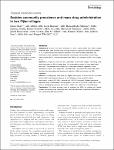Scabies community prevalence and mass drug administration in two Fijian villages
Haar, Karin
Romani, Lucia
Filimone, Raikanikoda
Kishore, Kamal
Tuicakau, Meciusela
Koroivueta, Josefa
Kaldor, John M.
Wand, Handan
Steer, Andrew
Whitfeld, Margot
Background: Scabies has been estimated to affect approximately 300 million people worldwide each year. Scabies rates are high and pose a significant public health problem in Fiji. Community-based comparison treatment trials have not been undertaken. We estimated scabies prevalence and compared the efficacy and tolerability of mass drug administration (MDA) of benzyl benzoate lotion (BB) or oral ivermectin (IVM) in two villages in Fiji. Methods: A prospective MDA trial was undertaken in two Fijian villages, comparing three daily applications of BB with single dose IVM or permethrin cream for those aged under two years. The therapies were offered to all community members regardless of the presence of scabies or its symptoms. The difference in prevalence was measured before and after the intervention and absolute risk reduction (ARR) and relative risk (RR) calculated. Results: In the BB group, there were 572 eligible participants, of whom 435 (76%) enrolled and 201 (46%) returned for follow-up. In the IVM group, there were 667 eligible participants, of whom 325 (49%) enrolled and 126 (39%) returned. Scabies prevalence was lower after the intervention in both groups. It fell from 37.9 to 20.0% (ARR 18.0%; RR 0.52) in the BB group and from 23.7 to 9.5% (ARR 14.2%; RR 0.40) in the IVM group. Conclusions: Our study provides proof of principle that MDA for scabies can reduce scabies prevalence at the community level, and that there was no significant difference in this trial between BB and oral IVM.
No license information

